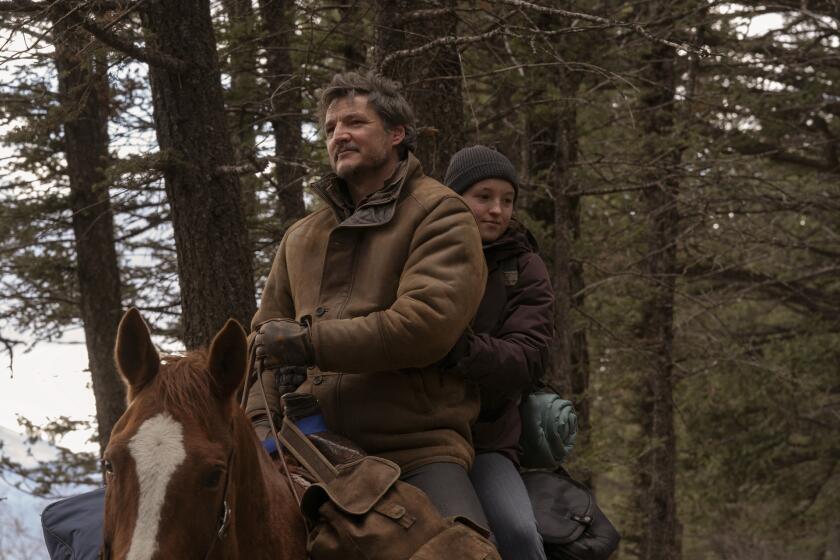CityWalk Opens at Universal : Entertainment: The two-block street is unveiled during a lavish celebration where guests mix with celebrities.
- Share via
It was the best of L. A. on display, looking great the L. A. way--with a lot of help from make-believe.
Universal Studios had a party for thousands Monday night to inaugurate its newest attraction, Universal CityWalk.
For the record:
12:00 a.m. May 27, 1993 For the Record
Los Angeles Times Thursday May 27, 1993 Valley Edition Metro Part B Page 3 Column 5 Metro Desk 2 inches; 48 words Type of Material: Correction
CityWalk Mural--A story Tuesday on the new CityWalk attraction at Universal Studios incorrectly identified Barbara Lazaroff as the painter of a mural on Wolfgang Puck’s Pizza Cafe. Although Lazaroff, the chef’s wife, designed the cafe interior and had overall responsibility for the mural, the painting was done by artist Mary Beth Hanrahan.
The guests sipped wine, downed sushi and mixed with celebrities, all in a setting that was the perfect essence of the City of Angels.
It was everything wacky and wonderful, everything gauche and gaudy that the unfettered spirit of the city has hatched over the last half a century or so, compressed in space and time around a neat two blocks of gray paving stones--without the miles of tract houses, mini - malls and freeways in between.
CityWalk is a gallery of the city’s cultural iconology from UCLA’s Royce Hall to the now almost vanished “googie architecture” of the ‘50s drive-in.
If it isn’t there in the stone and steel, its memory is lurking in a suggestive form, a color, a mood. It’s as if at any moment the Brown Derby might appear around a corner.
There’s no Brown Derby. But the pink Cadillac that’s stuck in the side of the Hard Rock Cafe at Beverly Center? Well, along CityWalk the other end is driving out of an ice cream store called Hollywood FreeZway, upside down.
Some of the images are real--so real you have to be told they’re not make-believe. Remember Conde’s? Brothers Ben and Raymond Conde used to switch roles each year as cook and maitre d’ of their Gardena restaurant and had the neon sign repainted each time with the face of the brother who was meeting the public. True story. And the sign is there to prove it, as is Mary Carter, director of the Museum of Neon Art, to tell it, along with the stories of 28 other original Los Angeles neons. The museum moved from downtown into CityWalk.
There are also real stores--selling things like dresses and $60 figurines of Arnold Schwarzenegger as The Terminator--and places where they sell real food, even if something doesn’t seem quite real about the places. There’s KWGB, a hamburger hut . . . in a make-believe radio station? And Gladstones, where diners sit beside real diving bells.
Wolfgang Puck’s Pizza Cafe is an honest L. A. original. The chef’s wife, Barbara Lazaroff, painted its facade with a zany three-dimensional mural featuring pizza pies as everything from the two O’s in the Hollywood sign to the drum in a Beatles-like band.
If you sense that it’s all meant to be in fun--good guess. But you can’t help thinking too that it’s meant to have some meaning too? Right again.
Pleased as punch to interpret is a beaming Jim Nelson, director of planning and development for MCA, who declares this the most exciting moment of his life.
The point, Nelson says, was not to ape Los Angeles of old, but “to create a modern entertainment city, to have a place that is integrated with the local community.”
None of the luscious visual gags refer to anything else specifically, Nelson says. They were created by a process he called “democratic design,” a term he said Lazaroff coined after MCA’s project team approved her pizza mural proposal.
MCA merely created the environment in the design by architect Jon Jerde and then let the tenants do their thing, he said.
“They’re people who took advantage of the design challenge that I gave them: Work in an environment that was not a mall,” Nelson said.
Even the neighborhood was consulted. Its wishes figured in the selection of some of the tenants--a UCLA extension campus, a bookstore and a Nature Company.
The Museum of Neon Art came in more serendipitously. One day CityWalk project manager David S. Froelich saw a crane lowering the old 48-foot-high neon flame from the doomed Gas Co. building. He was sad for a moment, knowing that the museum probably wanted the treasure but had no place to put it.
“Wait a minute,” he thought. “We have a place to put it.”
“You couldn’t get away with this if you were in Chicago,” Froelich said. “Everyone would want it to be a little more orderly and organized. In Los Angeles you don’t have to be organized.”
CityWalk has touched off some unfriendly assessments by critics who object to the retreat of public architecture into cloistered private places. A reviewer for Landscape Architecture dubbed it “enclavism,” a trend which, he prognosticated, “will continue to be the environmental response of this new-feudal generation (with) devastating consequences for the republic.”
Froelich was unfazed by such complaints.
CityWalk is a real city street, he said, not an amusement park. He points out there’s no entry fee. If you didn’t want to pay the $5 parking fee, you could even take a bus to Universal City and catch a studio tram to CityWalk.
But most of those who packed into the two-block street into the night Monday took the escalator down from the parking structure.
Very orderly, for L. A. folk.
More to Read
The biggest entertainment stories
Get our big stories about Hollywood, film, television, music, arts, culture and more right in your inbox as soon as they publish.
You may occasionally receive promotional content from the Los Angeles Times.











